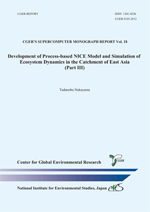NAKAYAMA T.
CGER Reports
CGER’S SUPERCOMPUTER MONOGRAPH REPORT Vol.18
It is very important to assess and predict ecosystem functions quantitatively and make scientifically sound policy recommendations for sustainable development concerning the degradation of environmental resources, including water resources, through human activities on a global scale. In particular, there are diverse and complex water-resources problems in combination with rapid economic growth and serious environmental degradation in East Asia (Fig. 1).
This monograph (Part III) succeeds Reports Vol. 11 (Part I, CGER-I063-2006) and Vol. 14 (Part II, CGER-I083-2008) published previously. Environmental pollution has recently come to be synonymous with degradation of water and thermal environments and contamination in urban areas. The development of the National Integrated Catchment-based Eco-hydrology (NICE) model combined with ground-based observation network and satellite data (Fig. 2), and simulation of ecosystem dynamics in catchments are therefore very important not only for the solution of these intertwined environmental degradations but also for the quantitative evaluation of catchments.
In this monograph the author reviews some examples of the model application to urban areas in Japan and China. For example, the author introduces some results on the clarification of water degradation by over-exploitation of water resources in the North China Plain (NCP) (Fig. 3), on the environmental assessment of ecosystem degradation in catchments accompanied by economic growth in urban areas (Fig. 4), and on the prediction of the mitigation of heat island by the effective management of water resources in the Tokyo metropolitan area (Fig. 5).
Though water resources are vital for human activity, their over-exploitation causes serious hydrologic change and ecosystem degradation in catchments. However, effective management of water resources is powerful for achieving a win-win solution to intertwined pollution problems in eco-conscious societies.







 PDF, 3.2 MB
PDF, 3.2 MB